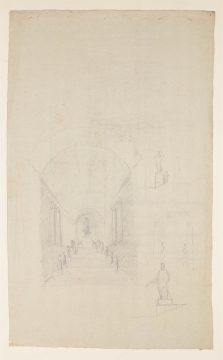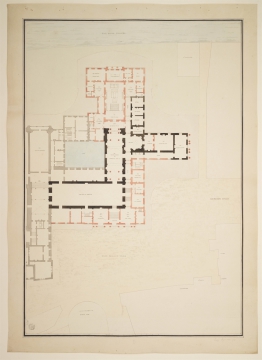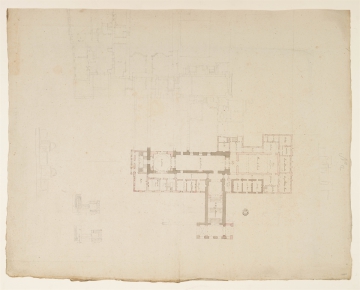
Browse
Reference number
Purpose
Aspect
5 Plan of ground floor with three entrances (for the King, for the Lords and, in the centre, a stair) on the west elevation
6-7 Plans of ground floor with Porte Cochere and stepped entrance on the south side
8 Unfinished plan of ground floor as drawings 7-8 with pencil amendment to Lord Great Chamberlain's office
Scale
Inscribed
(5) (pencil) D, labelled: The River Thames, Mr Delavals House, Abingdon Street, Mr Wilberforce, Mr Wharton, Mr Cowper, Mr Rose, Part of King Henry the / Seventh's Chapel, rooms labelled: Entrance, The / Hall / for / His Majesty, The / Hall / for / the Lords, The Court of Requests, The / Earl Marshall, The / Privy Seal, The / Lord Great / Chamberlain, Staircase, The / House of Commons, Court, The / Painted Chamber / and / Conference Room etca , Passage, Staircase, The / Witnesses, The / Committee Room, The / Prince's Chamber, Vestibule, Closet, The / Doorkeepers' / Lobby, The House of Lords, Lobby / and Gallery over it, The / Serjeant at Arms, Mr Cowper, Anti-Room, Mr Rose, Water / Closet, Anti Room, His Majesty's / Robing Room, The Doorkeepers / Lobby (twice), The / Lord Great Chancellor, Anti Room, The Bishops and The Archbishops
(6-7) as above, labelled: River Thames, Mr Delavals House, Abingdon Street, Old Palace Yard, Mr Wilberforce, Mr Wharton, Mr Cowper, Mr Rose, Part of King Henry the / Seventh's Chapel, Old Palace Yard, rooms labelled: Entrance, Hall (twice), Court of Requests, Staircase, Lord Great Chamberlain, Privy Seal, Lobby, Stove, Earl Marshall, Anti Room, Staircase, The Painted Chamber / for Conferences, Arcade, House of Commons, Vestibule, Porte Cochere, Black Rod, Coals etca, Staircase, Closet, Doorkeepers' / Lobby, Lobby / and Gallery over it, Serjeant at Arms, Mr Cowper, Anti Room, Mr Rose, Passage (twice), The House of Lords, Water Closet (twice), Urinal, Doorkeepers' Lobby, Lord Chancellor, Arch Bishops, Bishops, Prince of Wales and His Majesty's Robing Room
(7) (pencil) A1 and with Roman label
(8) (pencil) Copied, rooms labelled (in pencil, some too feint to read) Ld Gt / Chamb, Lord Great / Chamberlain, Servts attend / the House, door keeper, Black Rod, Lobby / & / Gallery over, (pen) Closet
Signed and dated
- (4) July 21 1794 (5, 6) (pencil) Copy Sepr 25 94
Medium and dimensions
Hand
Notes
As with all the schemes for the House of Lords, Soane preserves the Court of Requests, the Painted Chamber, the old House of Lords and (usually) a row of four offices to the east of the old Lords chamber and these are indicated in black wash (drawings 5-8). To the north (left-hand side) light sepia wash shows the old House of Commons in what was St Stephen's Chapel together with Soane's proposals for a new lobby and for a cloister which exceed his brief and hence, no doubt, the modest neutral wash.
In a red wash and above the Painted Chamber is shown the new House of Lords surrounded by offices and with a three-part entrance on the west side in Old Palace Yard (inscribed on drawing 5) for 'His Majesty', 'the Lords' and 'Staircase'. Drawings 6-8 have, on the south side, a porte cochere (re-using the Prince's Chamber) leading to a stepped entrance hall. This is first seen as a sketch perspective with statues on the verso of drawing 4. In drawing 5, the royal route from the King's entrance in Old Place Yard to the Lords chamber runs the entire length of the building with the King's Robing Room at the furthest end. The porte cochere with a stepped entrance hall, on the south side seen on drawings 6-8, reduces the length of the King's route and his Robing Room is more conveniently placed on the same side of the building.
S. Sawyer, 'Soane at Westminster'. PhD thesis, Columbia University, 1999, pp. 157-61, 163-5 puts drawing 4 (together with 9) as scheme 'A' in Soane's sequence of designs for the House of Lords. Drawing 5 represents design 'A2' together with an elevation (drawing 79). The final design (a 'synthesis of two planning approaches' taken from 'A1' to 'A6') includes drawings 5 and 6 (Sawyer, p. 180).
Level
Sir John Soane's collection includes some 30,000 architectural, design and topographical drawings which is a very important resource for scholars worldwide. His was the first architect’s collection to attempt to preserve the best in design for the architectural profession in the future, and it did so by assembling as exemplars surviving drawings by great Renaissance masters and by the leading architects in Britain in the 17th and 18th centuries and his near contemporaries such as Sir William Chambers, Robert Adam and George Dance the Younger. These drawings sit side by side with 9,000 drawings in Soane’s own hand or those of the pupils in his office, covering his early work as a student, his time in Italy and the drawings produced in the course of his architectural practice from 1780 until the 1830s.
Browse (via the vertical menu to the left) and search results for Drawings include a mixture of Concise catalogue records – drawn from an outline list of the collection – and fuller records where drawings have been catalogued in more detail (an ongoing process).










